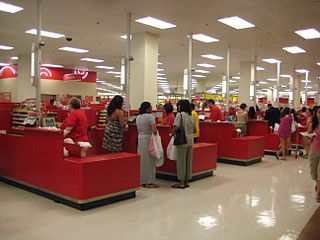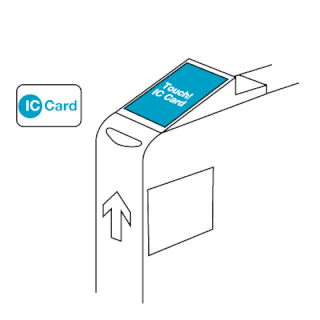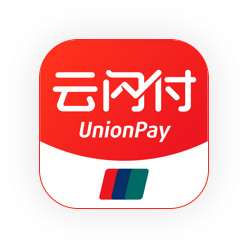Related Research Articles

The point of sale (POS) or point of purchase (POP) is the time and place at which a retail transaction is completed. At the point of sale, the merchant calculates the amount owed by the customer, indicates that amount, may prepare an invoice for the customer, and indicates the options for the customer to make payment. It is also the point at which a customer makes a payment to the merchant in exchange for goods or after provision of a service. After receiving payment, the merchant may issue a receipt, as proof of transaction, which is usually printed but can also be dispensed with or sent electronically.

Mobile payment, also referred to as mobile money, mobile money transfer and mobile wallet, is any of various payment processing services operated under financial regulations and performed from or via a mobile device. Instead of paying with cash, cheque, or credit card, a consumer can use a payment app on a mobile device to pay for a wide range of services and digital or hard goods. Although the concept of using non-coin-based currency systems has a long history, it is only in the 21st century that the technology to support such systems has become widely available.

A QR code,quick-response code, is a type of two-dimensional matrix barcode invented in 1994 by Masahiro Hara of Japanese company Denso Wave for labelling automobile parts. It features black squares on a white background with fiducial markers, readable by imaging devices like cameras, and processed using Reed–Solomon error correction until the image can be appropriately interpreted. The required data is then extracted from patterns that are present in both the horizontal and the vertical components of the QR image.

The EZ-Link card is a rechargeable contactless smart card and electronic money system that is primarily used as a payment method for public transport such as bus and rail lines in Singapore. A standard EZ-Link card is a credit-card-sized stored-value contact-less smart-card that comes in a variety of colours, as well as limited edition designs. It is sold by SimplyGo Pte Ltd, a merged entity of TransitLink and EZ-Link since 2024, a subsidiary of the Land Transport Authority (LTA), and can be used on travel modes across Singapore, including the Mass Rapid Transit (MRT), the Light Rail Transit (LRT), public buses which are operated by SBS Transit, SMRT Buses, Tower Transit Singapore and Go-Ahead Singapore, as well as the Sentosa Express.

Network for Electronic Transfers, colloquially known as NETS, is a Singaporean electronic payment service provider. Founded in 1986 by a consortium of local banks, it aims to establish the debit network and drive the adoption of electronic payments in Singapore. It is owned by DBS Bank, OCBC Bank and United Overseas Bank (UOB).

Alipay is a third-party mobile and online payment platform, established in Hangzhou, China in February 2004 by Alibaba Group and its founder Jack Ma. In 2015, Alipay moved its headquarters to Pudong, Shanghai, although its parent company Ant Financial remains Hangzhou-based.
A payment processor is a system that enables financial transactions, commonly employed by a merchant, to handle transactions with customers from various channels such as credit cards and debit cards or bank accounts. They are usually broken down into two types: front-end and back-end.
National Payments Corporation of India (NPCI) is an Indian public sector company that operates retail payments and settlement systems in India. The organization is an initiative of the Reserve Bank of India (RBI) and the Indian Banks' Association (IBA) under the provisions of the Payment and Settlement Systems Act, 2007, for creating a robust payment and settlement infrastructure in India.
An automated restaurant or robotic restaurant is a restaurant that uses robots to do tasks such as delivering food and drink to the tables and/or cooking the food.
Merchant Customer Exchange (MCX) was an American company created by a consortium of U.S. retail companies to develop a merchant-owned mobile payment system, which was to be called "CurrentC." The joint venture was announced on August 15, 2012.

GoPago was a cloud-based mobile payment platform with an integrated point of sale system, based in Pasadena, CA. GoPago's payment platform allows customers to purchase orders in advance of arriving at brick-and-mortar merchants and merchants to manage orders in real-time. In August 2012, GoPago released GoPago LIVE, an application-based tablet point of sale system, which are free to merchants. GoPago's mobile payments platform is cloud-based, which allows transactions processing without near-field communications or QR-code technologies. On December 11, 2013, Amazon reached an agreement with GoPago to buy a license to its technology and hire certain members of its engineering team. On December 20, 2013, mobile commerce company DoubleBeam acquired all of the assets of GoPago, including all customers, systems, products, brand name and IP portfolio. On February 20, 2015, DoubleBeam was acquired by Verifone, Inc, and GoPago was subsequently rebranded as Verifone Cloud POS.
FreedomPay is a company that provides payment platform as a service. It was founded in 2000 and is currently located in Philadelphia, Pennsylvania. In early 2000, FreedomPay launched mobile payment "proof of concepts" with enterprises such as McDonald's, Bank of America and Visa. Later in 2004, FreedomPay delivered a closed loop payment system for stored value and voucher systems to the food service industry.
WeChat Pay, officially referred to as Weixin Pay in China, is a mobile payment and digital wallet service by WeChat based in China that allows users to make mobile payments and online transactions. As of March 2016, WeChat Pay had over 300 million users. WeChat Pay reached 1.133 billion active users in 2023. WeChat Pay's main competitor in China and the market leader in online payments is Alibaba Group's Alipay. Alibaba company founder Jack Ma considered the red envelope feature to be a "Pearl Harbor moment", as it began to erode Alipay's historic dominance in the online payments industry in China, especially in peer-to-peer money transfer. The success prompted Alibaba to launch its own version of virtual red envelopes in its competing Laiwang service. Other competitors, Baidu Wallet and Sina Weibo, also launched similar features.
ChowNow is an online food ordering platform that connects customers with local restaurants. Christopher Webb and Eric Jaffe, American entrepreneurs, founded the company in 2011 with headquarters in Los Angeles, California.

Kakao Pay (Korean: 카카오페이) is a mobile payment and digital wallet service by Kakao based in South Korea that allows users make mobile payments and online transactions. The service supports contactless payments using near-field communications and QR codes.
A QR code payment is a mobile payment method where payment is performed by scanning a QR code from a mobile app. This is an alternative to doing electronic funds transfer at point of sale using a payment terminal. This avoids a lot of the infrastructure traditionally associated with electronic payments such as payment cards, payment networks, payment terminal and merchant accounts.

Faster Payment System is a real-time gross settlement payment system in Hong Kong that connects traditional banks and electronic payment and digital wallet operators. Users are able to perform instant money transfer or make payment to merchants by using the recipient's phone number, e-mail or QR code that contains the user's numeric identifier. Using the "traditional way" of full name and account number to make interbank transfer is also allowed.
Presto is a technology platform for the restaurant industry developed by Redwood City–based E la Carte. The company targets the customer-facing technology market for full-service and quick-service restaurants. Their products consist of computer vision, speech recognition, AI, tabletop tablets, and server tablets. As of October 2019, customers include Applebee's, Chili's, Outback Steakhouse, Denny's, Checkers, and Red Lobster.

Touch 'n Go eWallet is a Malaysian digital wallet and online payment platform, established in Kuala Lumpur, Malaysia, in July 2017 as a joint venture between Touch 'n Go and Ant Financial. It allows users to make payments at over 280,000 merchant touch points via QR code; pay for tolls, street parking, payment on e-hailing, car-sharing apps or taxis via RFID or PayDirect; pay bills; top-up mobile prepaid; pay for purchases on e-commerce websites or apps; order food delivery; perform peer-to-peer money transfers; renew car insurance and purchase unique insurance plans; and purchase movie, bus, trains, and airline tickets.

The app of UnionPay is a mobile and online payment service, developed and operated by UnionPay, the national Chinese bank card clearing service. Launched in 2017, it was designed to compete with the existing third-party Chinese mobile payment platforms, Alibaba Group's Alipay and Tencent's WeChat Pay. The mobile app allows the user to add their UnionPay bank card, and use it for various types of online and mobile payments, including in-app online payments, QR code payments, as well as contactless payments on NFC-enabled devices using UnionPay's QuickPass feature.
References
- 1 2 Casanova, Lourdes. (2020). The era of Chinese multinationals : competing for global dominance. Miroux, Anne. London: Academic Press. ISBN 978-0-12-817060-1. OCLC 1127953122.
- ↑ Crain, Marion G.; Poster, Winifred; Cherry, Miriam A. (28 June 2016). Invisible labor: hidden work in the contemporary world. Oakland, California. ISBN 978-0-520-96163-0. OCLC 949759576.
{{cite book}}: CS1 maint: location missing publisher (link) - ↑ "Contactless Dining: Exploring the Intersection of Hospitality and Technology". Modern Restaurant Management. 2020-07-08. Retrieved 2020-07-15.
- ↑ Kapur, P K; Singh, Ompal; Khatri, Sunil Kumar; Verma, Ajit Kumar (19 June 2020). Strategic system assurance and business analytics. Springer. ISBN 978-981-15-3647-2. OCLC 1162256890.
- ↑ The next frontier of restaurant management : harnessing data to improve guest service and enhance the employee experience. Susskind, Alex M.,, Maynard, Mark, 1967-. Ithaca. 15 June 2019. ISBN 978-1-5017-3652-0. OCLC 1075077371.
{{cite book}}: CS1 maint: location missing publisher (link) CS1 maint: others (link) - ↑ Zhang, Marina Yue; Dodgson, Mark (2007). "The Development of the Mobile Payment Industry in China". High-Tech Entrepreneurship in Asia. doi:10.4337/9781781007594.00014. ISBN 9781781007594.
- ↑ Harper, Damian; Chen, Piera; Eaves, Megan; Eimer, David; Elfer, Helen; Harper, Daisy; Holden, Trent; Lioy, Stephen; Low, Shawn; Masters, Tom (June 2017). China (15th ed.). Carlton, Victoria. ISBN 978-1-78657-522-7. OCLC 989510624.
{{cite book}}: CS1 maint: location missing publisher (link) - ↑ "Why Alipay will become one of the most Popular Payment…". Wirecard. Retrieved 2020-07-15.
- ↑ "China: preferred payment methods when dining out 2018". Statista. Retrieved 2020-07-15.
- ↑ Smart marketing with the internet of things. Simoes, Dora, 1970-, Barbosa, Belem, 1971-, Filipe, Sandra, 1973-. Hershey. 20 July 2018. ISBN 978-1-5225-5764-7. OCLC 1041707090.
{{cite book}}: CS1 maint: location missing publisher (link) CS1 maint: others (link) - ↑ "Reopening Guidelines" (PDF). CNN.
- ↑ PYMNTS (2020-05-19). "PayPal's QR Codes Bring Contactless Payments". PYMNTS.com. Retrieved 2020-07-15.
- ↑ PYMNTS (2020-07-08). "QR Codes Enjoy A Renaissance Post-COVID". PYMNTS.com. Retrieved 2020-07-15.
- ↑ PYMNTS (2020-07-13). "Coca-Cola Serves Up 'Pour By Phone' Feature". PYMNTS.com. Retrieved 2020-07-15.
- ↑ "Cohoes restaurant gets creative with new way of dining". NEWS10 ABC. 2020-07-03. Retrieved 2020-07-15.
- ↑ Dahmer, Sondra J. (2009). Restaurant service basics. Kahl, Kurt W. (2nd ed.). Hoboken, N.J.: John Wiley & Sons. ISBN 978-0-470-10785-0. OCLC 191207545.
- ↑ The next frontier of restaurant management : harnessing data to improve guest service and enhance the employee experience. Susskind, Alex M.,, Maynard, Mark, 1967-. Ithaca. 15 June 2019. ISBN 978-1-5017-3652-0. OCLC 1075077371.
{{cite book}}: CS1 maint: location missing publisher (link) CS1 maint: others (link)